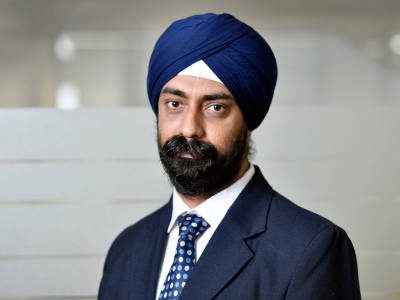Listen to this article
Over the last one year, equity markets have delivered returns below inflation with events of heightened volatility. On the other hand, the rate hike cycle in the fixed income markets has probably bottomed out and if experts have to be believed, it is the most opportune time to invest lumpsum in debt funds. Given this background, why do you think MFDs should continue to recommend a big lumpsum investment in a PMS focusing on equities?
Asset allocation approach is ideal while building client portfolios. It ensures you have the right debt-equity mix based on client’s risk profile and life goals. In the current environment, one can increase allocation to debt.
In 2023, a confluence of factors like higher inflation and interest rates, resurfacing of geopolitical issues and increasing risk of EL Nino have impacted equity markets. Consequently, valuations have corrected. On a 1-year forward basis, NIFTY trades at ~17.5x earnings in line with long-term average. While India continues to trade at a premium to some of its peers, we believe the premium is justified given the healthy earnings growth prospects.
A PMS product is a customised offering for HNIs. We believe the current uncertainty would also lead to emergence of interesting opportunities for investing and allow for bottom-up stock picking for healthy alpha generation. We continue to believe that investors with a 3- to 5-year view would benefit from investing in equities in the current scenario.
Of late, the PMS industry has undergone many changes, especially on the fund management side - single associate limit, increased compliance and so on. How will these changes impact the performance of funds?
The recent changes to PMS regulations are a welcome step for transparency and betterment of clients. Increased compliance will strengthen operations and risk management. Streamlining of return matrix would ensure like-to-like comparison across PMS schemes/strategies would make comparison easier for existing as well as potential clients.
PGIM India Core Equity Portfolio PMS has consistently beaten its benchmark. What are the three factors that have contributed to this performance?
We invest in structurally strong companies. A structurally strong company is a company that has reached a minimum scale in terms of revenue, has gone through at least one downcycle and emerged as a stronger company has a consistency in cash flows and higher return on capital employed over the last 10 years.
Further, we follow the philosophy of Growth at Reasonable Price (GARP) which is a simple yet effective principle of investing that has been time-tested for many years. While investing in equities is for growth, equally important is the price one pays for growth. GARP philosophy balances these two tenets of investing.
Also, we follow a concentrated approach towards portfolio construction with an average holding of 20-25 stocks. Our top holdings contributed meaningfully to our outperformance, thereby, reflecting the high conviction calls in the portfolio.
Close to 45% of the total assets of PGIM India Core Equity Portfolio is in mid caps. Why do you prefer mid cap companies over large and small cap companies?
As on February 2023, the portfolio composition of core equity (multi-cap strategy) is large cap (36%), mid cap (44%), and small cap (17%). Hence, the portfolio is well-diversified. Having said that, we believe mid and small cap segment have a long runway for growth along with strong balance sheets and reasonable valuations. The Nifty Mid Cap 150 index has corrected ~10% from the peak in December 2022, thereby making it an attractive opportunity from a 3- to 5- year perspective.
Moreover, as mentioned earlier, we follow the philosophy of Growth at Reasonable Price (GARP). Historically, we have seen the markets swing between extremes of optimism and pessimism - wherein we have seen approaches like growth at any price or focusing excessively on Price to Book value. GARP thus helps avoid extreme overpricing as well as avoiding value traps.
You are overweight on chemicals and industrials and underweight on technology. What are key reasons for this?
We are overweight on industrials mainly on account of the Make In India theme i.e. manufacturing. India’s long-awaited capex cycle finally seems to be gathering momentum after a hiatus of 10 years. While there were false starts in the last decade, we believe the recent post-COVID pick-up is looking sustainable and drivers are in place for a multi-year growth. Multiple engines of growth starting to fire together would lend stability and visibility to capital outlay in the economy over FY 2022-26.
While to an extent, the government capex growth would remain a function of tax collections, we believe private sector capex is at the cusp of pick-up owing to enablers such as deleveraged corporate balance sheets, healthy profitability, a well-capitalized banking system with NPA cycle over, rising domestic demand as well as mid-cycle capacity utilization.
Private sector capex has lagged government capex during FY 2020-22 but it will now outpace public spending due to increasing capex across multiple sectors (cement, metals, power, autos, chemicals and PLI-led capex).
We continue to be overweight on speciality chemicals as we believe China + 1 will continue to benefit the chemicals sector. There is a strong demand for fluorine molecules in pharmaceuticals, agrochemicals and new high growth applications, creating ~8 billion dollars global demand over FY 2022-27E. The opportunity in contract research & manufacturing services (CRAMS) could generate ~58 billion dollars demand globally over FY 2022-27E.
We have been underweight IT sector during the last two years. Large cap IT valuations have corrected sharply. After the recent correction, the risk-reward has become favourable with a majority of the global concerns getting priced-in.
Most IT services companies are currently trading at FY 2024 PEG (price/earnings to growth) of 1.3-1.5x. What in our view is not priced-in is if North America goes into a recession or goes through a pro-longed phase of stagflation, it can lead to cut in IT spends and earnings downgrades. We remain selective and have become neutral on the sector recently versus the broader market.




